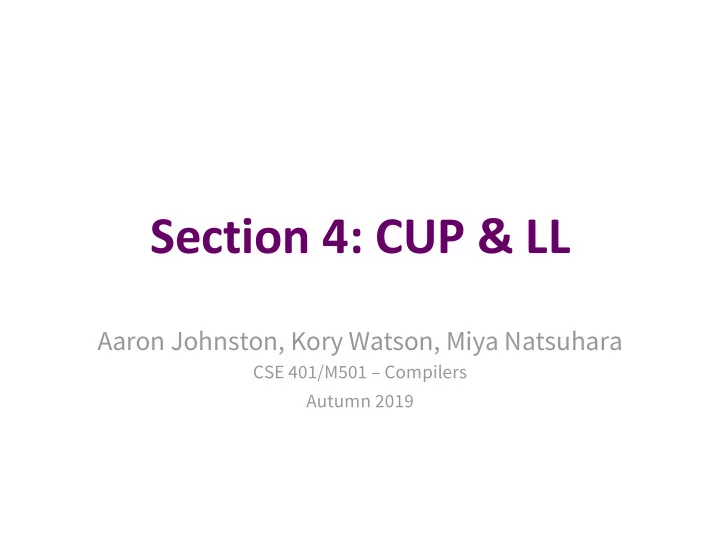

Section 4: CUP & LL Aaron Johnston, Kory Watson, Miya Natsuhara CSE 401/M501 – Compilers Autumn 2019
Administrivia • Homework 2 is due tonight! – You have late days if you need them • Parser is due one week from today • Scanner feedback by next week – Be sure to check when debugging parser
Agenda • CUP tips, tricks, and demo • AST class hierarchy and Visitor Pattern code • LL parsing – See Sec. 3.3 of Cooper & Torczon for more • A worksheet all about LL
The CUP parser generator • Uses LALR(1) – Weaker but faster variant of LR(1) • LALR is more sensitive to ambiguity than LR
Language Hierarchies
The CUP parser generator • Uses LALR(1) – Weaker but faster variant of LR(1) • LALR is more sensitive to ambiguity than LR • CUP can resolve some ambiguities itself – Precedence for reduce/reduce conflicts – Associativity for shift/reduce conflicts • If you use those features, read the docs carefully
The CUP parser generator Demo : testing and debugging a CUP parser
LL(k) parsing • LL( k ) scans left-to-right, builds leftmost derivation, and looks ahead k symbols • Typically k = 1, just like LR • The LL condition enable the parser to choose productions correctly with 1 symbol of look-ahead • We can transform a grammar to satisfy them
LL Condition For each nonterminal in the grammar: – Its productions must have disjoint FIRST sets A ::= x | B A ::= x | B B ::= x B ::= y – If it is nullable , the FIRST sets of its productions must be disjoint from its FOLLOW set S ::= A x S ::= A y A ::= ε | x A ::= ε | x
Factoring out common prefixes When multiple productions of a nonterminal share a common prefix, turn the different suffixes (“trails”) into a new nonterminal. Greeting ::= “ hello, world ” | “ hello, friend ” | “ hello, ” Name Name ::= “ Sarah ” | “ John ” | … Greeting ::= “ hello, ” Address Address ::= “ world ” | “ friend ” | Name Name ::= “ Sarah ” | “ John ” | …
Removing direct left recursion When a nonterminal has left-recursive productions, turn the different suffixes (”trails”) into a new nonterminal, appended to the remaining productions. Sum ::= Sum “ + ” Sum | Sum “-” Sum | Constant Constant ::= “ 1 ” | “ 2 ” | “ 3 ” | … Sum ::= Constant SumTrail SumTrail ::= “ + ” Sum | “-” Sum | ! Constant ::= “ 1 ” | “ 2 ” | “ 3 ” | …
Removing indirect left recursion • Pseudocode from Cooper & Torczon: • Rather conservative: no need to push A j into A i if you know that A j ⇏ α A i β for any α, β
Removing indirect left recursion When a nonterminal has another nonterminal (B) on the left of a production, rewrite that production to use all possible expansions of B. Repeat until the left side of every production is a terminal or direct left recursion. (Must choose an order to process nonterminals) Expr ::= Ternary | Addition Ternary ::= Expr “?” Expr “:” Stmt Addition ::= Expr “+” Expr Expr ::= Expr “?” Expr “:” Stmt | Expr “+” Expr
Worksheet • Discuss and work in small groups! • Reminders: – FIRST( ! ) is the set of terminal symbols that can begin a string derived from ! – FOLLOW( A ) is the set of terminal symbols that may immediately follow A in a derived string – nullable( A ) is whether A can derive "
Computing FIRST, FOLLOW, & nullable (3) = nullable Y 2 1 Y k : : if if X Y 1 Y 2 Y 3 Y k X Y 1 Y 2 Y 3 ::= ::= ... ... make nullable copy FIRST[ Y 3 ] to FIRST[ X ] X 3 4 Y k : Y k : if if X ::= Y 1 Y 2 Y 3 X ::= Y 1 Y 2 Y 3 ... ... copy FOLLOW[ X ] to FOLLOW[ Y 2 ] copy FIRST[ Y 3 ] to FOLLOW[ Y 1 ] UW CSE 401/M501 Autumn 2019 E-15
Computing FIRST, FOLLOW, and nullable repeat for each production X := Y 1 Y 2 … Y k if Y 1 … Y k are all nullable (or if k = 0) set nullable[ X ] = true for each i from 1 to k and each j from i +1 to k if Y 1 … Y i-1 are all nullable (or if i = 1) add FIRST[ Y i ] to FIRST[ X ] if Y i+1 … Y k are all nullable (or if i = k ) add FOLLOW[ X ] to FOLLOW[ Y i ] if Y i+1 … Y j-1 are all nullable (or if i+1=j) add FIRST[ Y j ] to FOLLOW[ Y i ] Until FIRST, FOLLOW, and nullable do not change
Recommend
More recommend